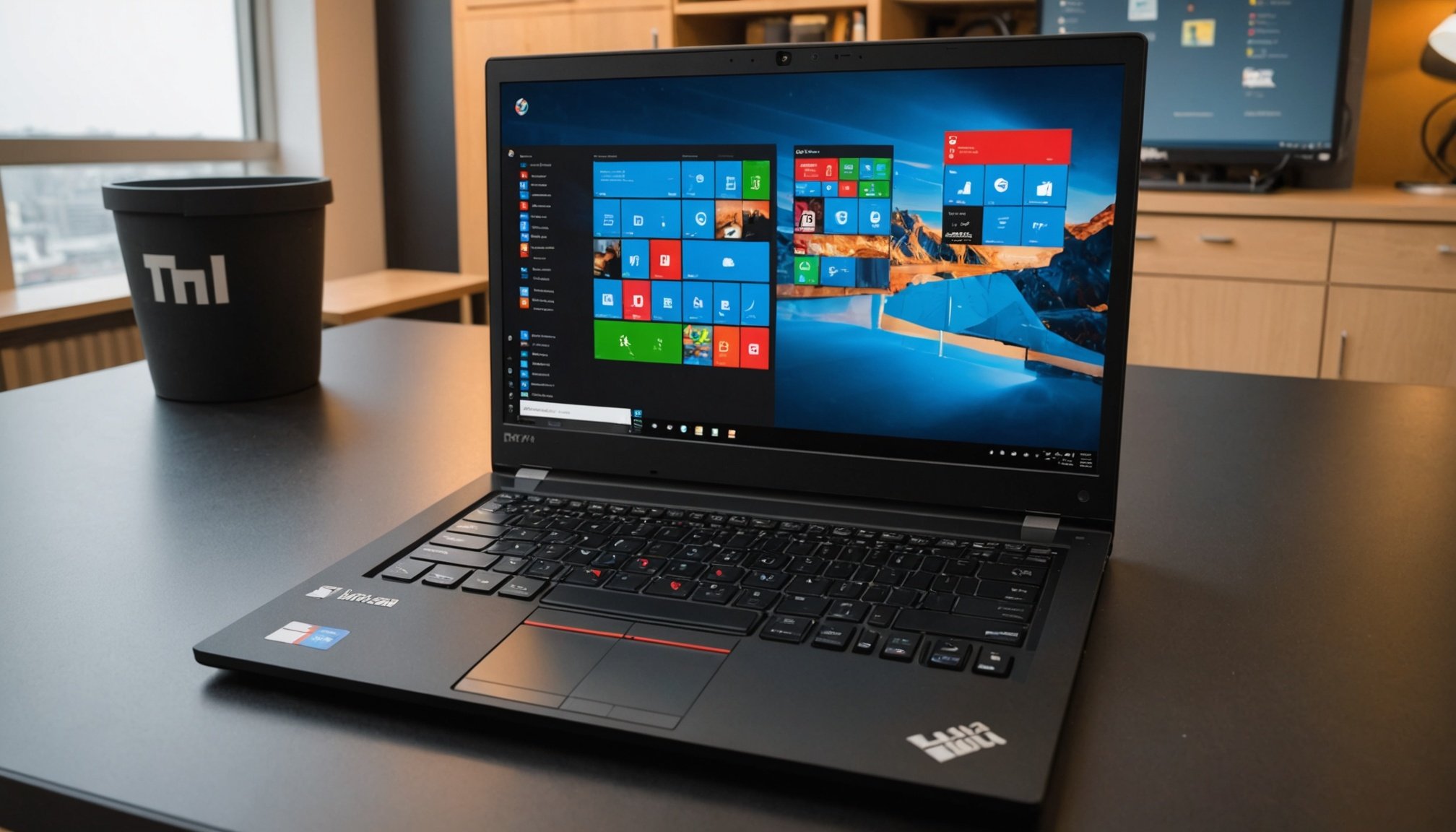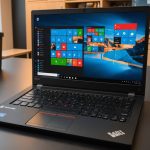Ultimate Guide to Dual-Booting Windows 10 and Manjaro Linux on Your Lenovo ThinkPad T14: An Expert Step-by-Step Tutorial
Preparing Your Lenovo ThinkPad T14 for Dual-Booting
Before you embark on the exciting journey of dual-booting your Lenovo ThinkPad T14 with Windows 10 and Manjaro Linux, it’s crucial to ensure your system is adequately prepared. Here are the key prerequisites to consider:
System Requirements
To run both Windows 10 and Manjaro Linux smoothly, your Lenovo ThinkPad T14 should meet certain hardware specifications. Here are the minimum requirements:
This might interest you : Maximize Your Gaming Potential: A Guide to Optimizing Ryzen 9 5900X and RTX 3090 in the Corsair 5000D Airflow Case
- RAM: At least 8GB, but 16GB or more is recommended for optimal performance[1][3].
- Storage: A minimum of 256GB of disk space, though having more is always beneficial. The ThinkPad T14 often comes with a 512GB M.2 SSD, which is more than sufficient[2].
- Processor: A multicore processor, such as the Intel i7-10510U, is ideal for handling the demands of dual-booting[2].
Data Backup
Backing up your data is a critical step to avoid any potential loss during the partitioning and installation process. Use reliable software like Macrium Reflect to create a complete system image and store it on an external drive. This ensures your data is secure in case of any errors or unforeseen incidents[1][3].
Partitioning
Understanding partitioning is key to a successful dual-boot setup. You will need to create separate partitions for each operating system. Here’s a suggested allocation:
This might interest you : Master High-Performance Video Editing: Your Ultimate Guide to Optimizing RAID 0 on Synology DS1621+ for Unmatched Results
- Windows 10: Around 50GB
- Manjaro Linux: Around 30GB
Use tools like GParted to resize existing partitions and create new ones as needed[1][3].
Installing Windows 10
If Windows 10 is not already installed on your Lenovo ThinkPad T14, here’s how you can install it:
Preparing the Installation Media
Download the Windows 10 ISO file using the Media Creation Tool from Microsoft’s official website. Create a bootable USB drive using tools like Rufus or Etcher[3].
BIOS Configuration
Restart your system and access the BIOS menu by pressing the designated key (usually F1, F2, or Del). Adjust the boot settings to prioritize the USB drive or CD/DVD drive containing the installation media[3].
Installation Process
Boot from the USB or disc and follow the on-screen installation prompts. Select your preferences for language, time, and keyboard input. Ensure all necessary hardware drivers and updates are in place after installation to avoid performance issues[3].
Installing Manjaro Linux
Installing Manjaro Linux is the next step in setting up your dual-boot system.
Preparing the Installation Media
Download the latest Manjaro Linux ISO from the official website and create a bootable USB stick using tools like Rufus or Etcher. Ensure your installation media is correctly structured to avoid boot failures[1][3].
BIOS Configuration
Restart your system and enter the BIOS to adjust the boot sequence settings, ensuring the system prioritizes the USB drive. Boot from the USB and proceed to the installation menu by selecting “Start Manjaro”[1][3].
Installation Guide
Choose “Manual Partitioning” to allocate the pre-shrunk space formatted in ext4. Assign mount points such as “/”, “swap”, and “/home” depending on your preference and storage capacity. The setup wizard will guide you through system configurations, including setting up your timezone, user account details, and password settings[1][3].
Configuring Dual-Boot Options
Once both operating systems are installed, configuring the boot loader is crucial for a seamless dual-boot experience.
Installing and Configuring GRUB
GRUB (GRand Unified Bootloader) is typically installed during the Manjaro installation. Ensure GRUB has correctly recognized Windows 10 by booting into Manjaro and running the command sudo update-grub in the terminal. This updates GRUB’s configuration files and includes all detected operating systems[1][3].
Customizing GRUB
To customize GRUB, edit the /etc/default/grub file to adjust settings such as boot time delay and default operating system. Save the changes and update GRUB by executing sudo update-grub to apply the modifications[1][3].
Troubleshooting GRUB Issues
Occasionally, issues might arise where GRUB fails to recognize one of the operating systems. Use tools such as Boot Repair or command-line options to troubleshoot and resolve these problems. Accessing guidance from the Manjaro Linux community can also provide valuable resources and support[1][3].
Post-Installation Configuration
After the installation, there are several steps to ensure your dual-boot setup is fully functional and optimized.
Networking Preferences
Configure system settings to smoothly integrate with Windows, such as setting networking preferences. This ensures both operating systems can access the internet and network resources without issues[1].
Installing Essential Applications and Drivers
Install essential applications and drivers to ensure optimal performance and system stability. This includes updating any necessary hardware drivers and installing software that you frequently use[1][3].
Troubleshooting Common Issues
Dual-booting can sometimes come with its own set of challenges. Here are some common issues and how to troubleshoot them:
Secure Boot Errors
Ensure that Secure Boot is disabled in the BIOS settings, as it might prevent Linux from installing. If you encounter Secure Boot errors, adjust the BIOS settings to UEFI mode and disable Secure Boot[1][3].
Partitioning Errors
If you encounter errors during partitioning, use tools like GParted to manage and adjust your partitions. Ensure that you have allocated enough space for each operating system and that the partitions are correctly formatted[1][3].
Boot Loader Issues
If GRUB does not display as expected, verify the boot sequence settings in the BIOS and ensure the primary boot device is correctly assigned. Running sudo update-grub in the terminal can also resolve issues where GRUB fails to recognize one of the operating systems[1][3].
Practical Tips and Advice
Here are some practical tips to make your dual-boot experience smoother:
- Regular Backups: Regularly back up your data to avoid any potential loss. Use cloud storage or external drives to keep your data secure.
- Software Compatibility: Ensure that the software you use is compatible with both Windows 10 and Manjaro Linux. This can save you from having to find alternative applications.
- Community Support: Join the Manjaro Linux community for support and resources. The community is often very helpful in resolving issues and providing tips.
- Keep Your System Updated: Regularly update both your Windows 10 and Manjaro Linux installations to ensure you have the latest security patches and features.
Detailed Steps in a Nutshell
Here is a detailed bullet point list summarizing the key steps for dual-booting Windows 10 and Manjaro Linux on your Lenovo ThinkPad T14:
- Prepare Your System:
- Ensure adequate hardware specifications (RAM, storage, processor).
- Back up your data using reliable software.
- Understand and manage partitioning.
- Install Windows 10:
- Download the Windows 10 ISO and create a bootable USB.
- Configure BIOS settings to prioritize the USB drive.
- Follow on-screen installation prompts.
- Install Manjaro Linux:
- Download the Manjaro Linux ISO and create a bootable USB.
- Configure BIOS settings to prioritize the USB drive.
- Choose manual partitioning and assign mount points.
- Configure Dual-Boot Options:
- Install and configure GRUB.
- Customize GRUB settings if necessary.
- Troubleshoot GRUB issues.
- Post-Installation Configuration:
- Configure networking preferences.
- Install essential applications and drivers.
- Troubleshooting Common Issues:
- Address Secure Boot errors.
- Manage partitioning errors.
- Resolve boot loader issues.
Comparative Table: Windows 10 vs Manjaro Linux
Here is a comparative table highlighting some key differences and similarities between Windows 10 and Manjaro Linux:
| Feature | Windows 10 | Manjaro Linux |
|---|---|---|
| Operating System | Proprietary | Open-source |
| User Interface | Windows Explorer | Various desktop environments (e.g., KDE, GNOME, XFCE) |
| Software Availability | Wide range of proprietary and open-source software | Primarily open-source software |
| Hardware Compatibility | Generally good support for a wide range of hardware | Good support, but may require additional configuration for some hardware |
| Security | Strong security features, including Windows Defender | Strong security features, including firewall and encryption options |
| Community Support | Large user base, extensive support resources | Active community, extensive support resources |
| Cost | Licensed, requires purchase | Free, open-source |
| Gaming | Excellent support for video games | Good support, but may require additional configuration for some games |
| High-Tech Features | Integrated support for smart home devices, smartphones, and more | Can be integrated with smart home devices and smartphones with additional setup |
Quotes and Insights
- “Dual-booting allows you to leverage the strengths of both Windows and Linux, making it an ideal setup for users who need the versatility of different operating systems.” – ThinkPad Mike
- “The key to a successful dual-boot setup is careful planning and preparation. Ensuring your hardware and software specifications meet the requirements for both operating systems is pivotal.” – My Tech Community
- “GRUB is a powerful tool that simplifies the process of switching between operating systems. Properly configuring GRUB ensures a seamless dual-boot experience.” – E-Reserve
Dual-booting Windows 10 and Manjaro Linux on your Lenovo ThinkPad T14 can be a rewarding experience, offering the best of both worlds in terms of functionality and flexibility. By following the detailed steps outlined in this guide, you can ensure a smooth and efficient setup process. Remember to always back up your data, manage partitions carefully, and configure GRUB correctly to enjoy a hassle-free dual-boot experience.
Whether you’re a high-tech enthusiast looking to explore the cutting-edge features of both operating systems or a user needing the procedural generation capabilities of Linux alongside the gaming prowess of Windows, this guide has you covered. With the right preparation and mindset, you can unlock the full potential of your Lenovo ThinkPad T14 and dive into a world of limitless possibilities.











